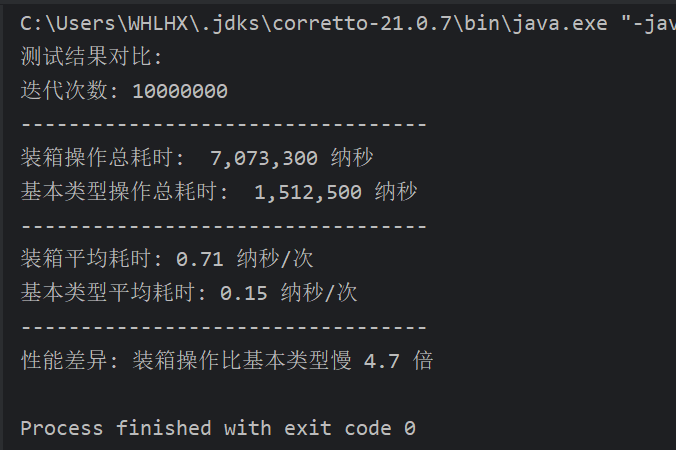目录
一、装箱与拆箱基础概念
1. 什么是装箱和拆箱
装箱(Autoboxing):将基本数据类型自动转换为对应的包装类对象
int i = 10;
Integer integerObj = i; // 自动装箱拆箱(Unboxing):将包装类对象自动转换为基本数据类型
Integer integerObj = new Integer(10);
int i = integerObj; // 自动拆箱2. 基本类型与对应包装类
| 基本类型 | 包装类 | 缓存范围 |
|---|---|---|
| byte | Byte | -128 ~ 127 |
| short | Short | -128 ~ 127 |
| int | Integer | -128 ~ 127 |
| long | Long | -128 ~ 127 |
| float | Float | 无缓存 |
| double | Double | 无缓存 |
| char | Character | 0 ~ 127 |
| boolean | Boolean | true, false |
二、装箱与拆箱的实现原理
1. 编译器如何处理?
以下代码展示了编译器如何处理装箱和拆箱:
// 源代码
Integer i = 10;
int j = i;
// 编译器处理后
Integer i = Integer.valueOf(10);
int j = i.intValue();2. 字节码分析
使用javap -c查看字节码:
0: bipush 10
2: invokestatic #2 // Method java/lang/Integer.valueOf:(I)Ljava/lang/Integer;
5: astore_1
6: aload_1
7: invokevirtual #3 // Method java/lang/Integer.intValue:()I
10: istore_23. 缓存机制详解
包装类对常用值进行了缓存优化:
public static Integer valueOf(int i) {
if (i >= IntegerCache.low && i <= IntegerCache.high)
return IntegerCache.cache[i + (-IntegerCache.low)];
return new Integer(i);
}缓存范围可通过JVM参数调整:
-XX:AutoBoxCacheMax=<size>三、使用场景与最佳实践
1. 集合中的自动装箱
List<Integer> list = new ArrayList<>();
list.add(1); // 装箱
int num = list.get(0); // 拆箱2. 方法参数传
public void process(Integer num) {
int value = num; // 拆箱
}
process(123); // 装箱3. 三元运算符中的陷阱
Integer result = condition ? 100 : null;
// 会抛出NullPointerException4. 最佳实践总结
- 优先使用基本类型:局部变量、方法参数等
- 集合中必须使用包装类:泛型不支持基本类型
- 比较使用equals():避免==比较包装类对象
- 注意null值处理:拆箱前检查null
- 性能敏感场景避免频繁装箱:如循环体内
四、性能影响与优化
1. 性能测试对比
public class BoxingPerformanceTest {
public static void main(String[] args) {
final int ITERATIONS = 10_000_000; // 测试次数
// 测试装箱性能
long boxingStart = System.nanoTime();
for (int i = 0; i < ITERATIONS; i++) {
Integer j = i; // 自动装箱
}
long boxingDuration = System.nanoTime() - boxingStart;
// 测试基本类型性能
long primitiveStart = System.nanoTime();
for (int i = 0; i < ITERATIONS; i++) {
int j = i; // 基本类型赋值
}
long primitiveDuration = System.nanoTime() - primitiveStart;
// 输出结果
System.out.println("测试结果对比:");
System.out.println("迭代次数: " + ITERATIONS);
System.out.println("----------------------------------");
System.out.printf("装箱操作总耗时: %,d 纳秒\n", boxingDuration);
System.out.printf("基本类型操作总耗时: %,d 纳秒\n", primitiveDuration);
System.out.println("----------------------------------");
System.out.printf("装箱平均耗时: %.2f 纳秒/次\n", (boxingDuration / (double)ITERATIONS));
System.out.printf("基本类型平均耗时: %.2f 纳秒/次\n", (primitiveDuration / (double)ITERATIONS));
System.out.println("----------------------------------");
System.out.printf("性能差异: 装箱操作比基本类型慢 %.1f 倍\n",
(boxingDuration / (double)primitiveDuration));
}
}测试结果:

2. 优化策略
-
使用基本类型数组:
int[] array = new int[1000]; // 优于Integer[] -
避免不必要的包装:
// 不好 Integer sum = 0; for (int i = 0; i < 1000; i++) { sum += i; // 反复装箱拆箱 } // 优化 int sum = 0; for (int i = 0; i < 1000; i++) { sum += i; // 纯基本类型操作 } -
利用缓存值:
// 使用缓存范围内的值 Integer a = 100; // 使用缓存 Integer b = 1000; // 新建对象
五、常见问题与陷阱
1. 空指针异常
Integer num = null;
int i = num; // NullPointerException解决方案:
int i = (num != null) ? num : 0;2. 比较陷阱
Integer a = 100;
Integer b = 100;
System.out.println(a == b); // true
Integer c = 200;
Integer d = 200;
System.out.println(c == d); // false正确做法:
System.out.println(a.equals(b)); // 使用equals更为稳妥3. 性能陷阱
Long sum = 0L; // 包装类
for (long i = 0; i < Integer.MAX_VALUE; i++) {
sum += i; // 每次循环都拆箱和装箱
}优化方案:
long sum = 0L; // 基本类型
for (long i = 0; i < Integer.MAX_VALUE; i++) {
sum += i; // 无额外开销
}六、高级应用场景
1. 反射中的类型处理
Method method = clazz.getMethod("setValue", Integer.class);
method.invoke(obj, 123); // 自动装箱2. 注解属性值
@Retention(RetentionPolicy.RUNTIME)
public @interface Example {
int value(); // 基本类型
Class<?> type(); // 引用类型
}
@Example(100) // 基本类型直接赋值
class Sample {}3. 函数式编程
IntStream.range(1, 10) // 基本类型特化流
.boxed() // 显式装箱为Stream<Integer>
.collect(Collectors.toList());七、JVM层面对比
1. 内存占用差异
| 类型 | 内存占用 |
|---|---|
| int | 4字节 |
| Integer | 16字节 |
| long | 8字节 |
| Long | 24字节 |
2. 对象头开销
包装类对象有12字节的对象头(32位JVM)或16字节(64位JVM)
3. GC影响
频繁创建包装类对象会增加GC压力
八、Java 装箱与拆箱存在的核心意义
1. 兼容泛型与集合(类型统一化)
- 问题:Java 泛型(如
List<T>)不支持基本类型(int、long等),只能存储对象。 - 解决方案:
意义:让基本类型能用于泛型集合,统一面向对象和基本类型的编程模型。List<Integer> list = new ArrayList<>(); list.add(100); // 自动装箱:int → Integer int num = list.get(0); // 自动拆箱:Integer → int
2. 支持 null 值(缺失值表达)
- 问题:基本类型(如
int)不能为null,但某些场景需要表示“无值”(如数据库字段可能为NULL)。 - 解决方案:
意义:通过包装类明确区分“0”和“无值”。Integer result = getFromDatabase(); // 可能返回 null if (result != null) { int value = result; // 拆箱 }
3. 反射与框架集成(动态操作)
- 问题:反射 API(如
Method.invoke())和主流框架(如 Spring、Hibernate)需要操作对象而非基本类型。 - 示例:
意义:使基本类型能通过反射动态调用。Method method = obj.getClass().getMethod("setValue", Integer.class); method.invoke(obj, 100); // 自动装箱:int → Integer
4. 数值缓存优化(性能权衡)
- 机制:
Integer.valueOf()对-128~127缓存对象,避免重复创建。 - 意义:
- 减少高频小数值的内存分配(如循环中的临时变量)。
- 通过
==可直接比较缓存范围内的对象(但超出范围需用equals())。
5. 运算符重载(语法糖便利性)
- 示例:
意义:让包装类能像基本类型一样直观运算(背后隐藏拆箱/装箱)。Integer a = 100; a++; // 实际步骤:拆箱 → 运算 → 装箱






















 738
738

 被折叠的 条评论
为什么被折叠?
被折叠的 条评论
为什么被折叠?










